What streetcar did for the Pearl District, bikes are doing for North Williams Avenue. O.K., so maybe it’s not quite an equal comparison, but the presence of bike traffic on Williams has encouraged its share of development and the influx of bike-friendly businesses popping up along the street shows no sign of letting up.
Newcomers Queen Bee Creations and Vergnetti’s Coffee are just the latest businesses who are embracing — and adding to — the street’s bike-oriented reputation.
Queen Bee has found great success with their handmade bike panniers. The company employs 13 people, most of whom can be seen working away at sewing machines tucked behind a small retail space at the front of the shop.
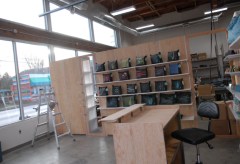
Dana Hinger, Queen Bee’s business and operations manager, says the Williams location fits the company much better than their former location on East Burnside. “I’d much rather see bikes than all the cars on Burnside… We’re so happy to be here.” In addition calmer traffic, Hinger noted that people who ride bikes mesh well with Queen Bee’s values of community and a do-it-yourself ethic.
Queen Bee shares a wall with United Bicycle Institute, the state licensed vocational school that moved in back in October. UBI was courted by real estate developer John Kellogg (who has developed several properties in the area). Kellogg’s vision is to make the entire corner of Williams and Shaver “biker central.”
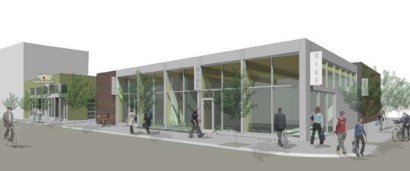
There’s one spot left in the development (on the corner) and Kellogg says he’s “Still trying to find the right bike-centric tenant.” Kellogg isn’t shy about putting bikes front and center in his sales pitch. The first bullet-point on the sales flyer says it’s a “bike centric project.”
Just south of UBI and Queen Bee, another new project is in the works that will up the bike ante even more. The Ecoflats apartment complex will have 21 units and according to Neighborhood Notes, the architect has big plans for bikes.
Veillet has designed Ecoflats with the bike community in mind. The project will offer these bike-friendly features:
* bike lockers on each floor, so residents won’t have to store their bikes in their unit
* An on-site bike maintenance room for resident use.
*Stairways will feature wheel troughs, which will allow bikes to be easily rolled up and down stairs.[An update from Neighborhood Notes finds that an ADA mandated elevator has narrowed the stairway and the developer can no longer build the wheel trough.]“
Vergnetti’s Coffee, another business that has sprung up in the last few months, makes their bike love obvious: Two signs made out of bikes hang off the front of their building and a flyer on the window proudly announces, “Bike parking inside!”.
Vergnetti’s joins Lincoln Restaurant (who has dubbed the area the “Bike Commuter Corridor” and even has a special happy hour for bike riders) and the bike business duo of Pedal Bike Tours and Metropolis Cycle Repair who moved into lower Williams back in 2008.
All of this bike traffic and business activity has come at a very low cost to the City of Portland. Williams registered 2,750 daily bicycle trips (at N. Russell) in the 2009 bike counts, making it one of the most popular bike routes in the city despite the fact that it has only a standard-width bike lane and is not always the most pleasant place to ride. Not a bad return on investment.
PBOT hopes to upgrade the bike lane to a cycle track soon. When that happens, we can expect the bike-oriented development to continue.



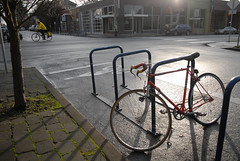
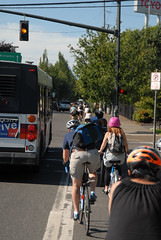
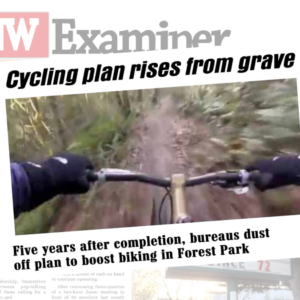

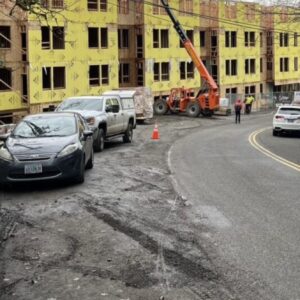

Thanks for reading.
BikePortland has served this community with independent community journalism since 2005. We rely on subscriptions from readers like you to survive. Your financial support is vital in keeping this valuable resource alive and well.
Please subscribe today to strengthen and expand our work.
PBOT should take Williams down to one lane for motor vehicles while they are at it…replace a “race track” with a cycle track and sloooow things down.
Yea! I love the commute through Williams all the way to my house on Williams. What a great bit of life and scenery and urban collectiveness to have in a straight line.
This is SWEET! I ride my bike by here all the time. I was wondering what that shop was, it is Queen Bee and UBI too, awesome!I love this little area, it helps my house and Bike Temple are only a few blocks away in either direction. Now just to get Going as a Bicycle Boulevard…
When I ride Williams we are never the only cyclists or even the minority mode of traffic – it makes me smile every time.
I don’t think Williams needs to have cyclists slow down, but having a second bicycle lane such as is found on the Hawthorne Bridge for easier passing is probably overdue.
I’ll second Lenny’s wish for Williams to be reduced to one lane for motor traffic. I’d like to see a post here that details all the possible layouts/configurations. Put the bikes on the left side in their own lane? What about eliminating parking on one side? Someone smarter than me has no doubt thought this through already.
Not slow bikes down! We need to slow down the motor vehicles; two lane couplets always produce excessive speed and are unsafe for pedestrians and bicyclists. The challenge is how to manage buses and bikes; whoever solves that one deserves the Nobel prize.
As an out-of-towner with an undisciplined sense of curiosity, I looked over the area on Google Street View – the pictures there are woefully out of date.
I have a couple of questions.
Williams appears to be the northbound half of a couplet with Vancouver. Assuming that most people going north on Williams will at some time also head south, is there any similar development in the area over on Vancouver? Or is it a matter of catching the traffic flow in the right direction at the right time of day?
Vancouver appears to have only a single lane of motor vehicle traffic. This supports Lenny (#1) in his suggestion to put Williams on a diet as well.
The next time I’m in town, this sounds like a great place to stop just for the ambiance.
buglas,
yes, there has been some development on the Vancouver piece of the couplet… but not quite as much.
And you’re right, Vancouver has gone on a diet in recent years. It also has the city’s widest bike lane and it is quite pleasant to ride in. One big difference is that the Vancouver side is downhill, which makes the riding easier and the speed differential with cars much lower.
It’s a matter of when, not if, the city makes a big change on Williams — but that when depends on political guts and public pressure as much as policy and budgets.
Williams has seen much more development than Vancouver in part b/c Williams had a lot more under used warehouse/commercial buildings While Vancouver is mostly single family residences. Both streets have ample vacant lots that should be developed in the next 5- 10 years, particularly the big lots on both sides of Fremont b/n Vancouver and Williams. The real estate slump has really killed the near term feasibility of the bigger projects.
One of the ironic things about this Williams resurgence is that it is happening a half mile north of the old Williams business district that Emmnauel Hosp. destroyed in their aborted 70’s expansion.
As one of Dana Hinger’s former fellow ‘Lemmings’, I will vouch that she is relentless on a bike.
The danger-dance between bikes and buses on Williams could be made much safer if the cycle track or bike lane was relocated to the left side of the street. Right now the situation is as sketchy and dangerous as can be. Bus drivers hate it.
Lefty’s spot on about buses. That’s one of my biggest concerns when we are pedaling Williams – but it’s still a great street buses and car speed not withstanding and I’m thrilled with all the bikecentric biz setting up shop along it.
There’s a lot of work to be done to figure out how to best manage bike/auto/bus traffic on this street.
I’ve just been invited to a “Branding Williams” n’hood business meeting so perhaps I’ll jump into this a bit more. I could envision a bikeportland event where we get riders, business owners, BTA, PBOT staff, etc.. into the same room to hash out some ideas, voice feedbacks, find some cash, and set out a plan for action.
maybe in late February we do a Williams Avenue Get Together? What would you all think of that?
With the redesign of Williams…’road diet’…would it make sense to make it a wider bi-directional biketrack – for local trips…and keep the ‘downtown bound’ peak hour commuters on Vancouver? [If placed on the left side of the street – there would be less bus bike conflict.]
I assume the redesign of Williams would have greater overall support if parking capacity were more protected vs. traffic capacity (# of lanes).
Perhaps with a left side bi-directional bike track layout car parking could be consolidated on the right side with back-in diagonal parking. This would open up the visibility of bicyclists for turning traffic. [Side street parking could be augmented where needed and appropriate with back-in parking too – where more car dependent businesses currently might be.]
Jonathan,
This is exactly the kind of “City Vital” place that economist Joe Cortright describes in which talent, innovation, community connections and a distinctive place converge. While the PDC has helped plant the seeds of Williams Corridor development, what is needed now is additional strategic investments from the commission to build upon these efforts and catalyze additional similar uses. PDC’s Interstate Urban Renewal Area TIF funds should be used create a Williams Bicycle Centered Development Strategy and Plan that leverages this organic growth in something even greater. This center could in turn be used as an example of how bicycles, like the streetcar can be used as a tool for fostering neighborhood revitalization. In the end, linking the investment of bicycle infrastructure with economic development is the only way of convincing decision makers that more money should be spent above and beyond the meager amount that PBOT has committed to recently.
Buglas raises a good question – if Vancouver can go to one lane, why not Williams? As someone who worked on the planning & design for Vancouver /Williams bike lanes in the late 90’s, my recollection is that we were able to take (parts of) Vancouver to one lane because the peak traffic is in the AM, and is not as pronounced a peak as Williams is, with a higher PM traffic peak.
Also, we didn’t have much of a choice – because much of Vancouver is slightly narrower than Williams (36 feet wide vs. 40 feet wide) something had to give, either travel lane or parking, to fit in a bike lane on Vancouver.
On Williams we had the luxury of not pushing the envelope – and it was a considerably smaller envelope, indeed, in those days – so we didn’t.
Great to see Williams suffering from overuse these days, because when it first went in i was concerned it might have a hard time finding many users…
Wow! After reading this article and some of the comments, I think when my wife and I buy our first house next year we’ll be looking into NoPo.
We’ve always loved the area and I think houses are (relatively) affordable. Add in the ease of getting into Downtown without a car (we live life sans auto) and it’s a no-brainer.
John Kellogg – what are your plans for additional secured covered bike parking for shoppers and tenants? When I am down at PIX/ 5th Quad…the bike corrals are often full.
…Bikestation has a nice looking modular bike parking structure for ~36 bikes with a security system that can easily be dropped onto a surface car parking lot.
This would be an amenity that would set your properties above your competitors.
Let us know if you would like to know more about it. todd.boulangeratyahoodotcom
One comment getting back the to more general discussion of bike-related business development on Vancouver/William: I am pretty darn disappointed with the placement of the two on-street bike parking corrals on Williams at N Failing. This is where Pix, the 5th Quadrant, Lincoln, Eat Oyster Bar, etc. are located.
I’m bummed that the corrals were not located directly on Williams. I think the street misses out on a lot of the fringe benefits bike corrals bring to a neighborhood by where they are currently placed. Right now there are two corrals on either side of Williams on N. Failing.
My sense is that if the corrals were on Williams it would have done a lot more to help the businesses (and more of them). There would have been a number of subtle but important benefits: It would have slowed car traffic. A corral on the east side of Williams would have improved visibility for traffic on Failing crossing Williams. The corral on the east side of Williams is out of the way. I am personally uncomfortable locking my bike up there because I can’t keep an occasional eye on it while I drink coffee of have a beer at Eat. Also it would have been a lot more useful for business to have it located closer to the businesses.
The big benefit, subtle though it is, would be that bike corrals create a sense of things happening for people passing by in cars. For the east side corral, having the it relatively out of sight detracts from this fringe benefit.
HA! Funny to read about businesses along Williams being “bike friendly”. I used to commute up Williams-all the way from Broadway to just past Portland Blvd-and finally changed routes because riding Williams was the most frightening street that I’d ever ridden. The main reason was the cross traffic, exacerbated by stopped traffic on Williams leaving gaps so cross traffic could sneak through. I nearly became a statistic a few times. Finally switched to the west side of I-5 (Interstate and Concord). Much safer.
And the gentrification continues…
@borgbike #20 — Agreed. This is my neighborhood and I don’t like the placement of these racks. Further, the racks on the east side of Williams are usually under-utilized while those outside of Pix are generally overflowing. I’d bet a lot of folks who roll up to the businesses on the east side of Williams don’t know about that corral — I actually think it’s too far from most of them to be effective for drop in shopping. If the corral had been located next to the motorcycle parking on Williams, I think the benefit would have been greater.
When you compare the amount of money invested to spur economic development on Williams compared to streets with LR or streetcar,its peanuts. For its failings, Williams is the most workable route to commute north for most. Its only natural that all these businesses open on Williams, as there is a natural flow of customers every day there. That the bike would be the low cost catalyst for such development is something to other communities to consider.
the main issue with leapfrogging buses is south of fremont, and it would be tricky to move bike traffic to the left through there because you first have to get past the interstate five exit, and a lot of bike traffic turns right at tillamook. not really a fan of the striped bike lane anywhere on williams, but until fremont it is essentially unusable, and i generally get into the travel lane. north of fremont everything opens up.
All this development feels very white to me.
I’ve lived in NE since 1995 and have watched the overall demographic of the area change — as many historically black neighborhoods have gradually transitioned to mostly-white (and mostly younger) ones. in place where the demographic remains mostly black, houses remain in disrepair, and whole blocks remain run-down and economically depressed.
Where will the longest-term residents of NE Portland go if they cannot afford to stay in their homes as property values are driven up?
Will northeast Portland be in danger of a sort of micro-homogenization (by race/class/income group), as has happened in other eastside neighborhoods over the last 10-15 years?
Is our very human propensity to group with “others just like us” a byproduct of gentrification, or a true force behind it? What happens to our socialization — and to our childrens’ socialization — when we create such homogenous communities?
Is Portland’s historic status as the whitest city on the west coast something that cannot be overcome? Do we really want diversity in our neighborhoods, or would we prefer to just talk about it? And who among us will be honest enough to admit what they really want when they envision the neighborhood of their dreams?
Most importantly, why aren’t more of us having these discussions, even as we repair and clean up our neighborhoods and bring old buildings and streets into updated use?
When we talk about development, we should remember that transportation issues don’t operate in a vacuum.
Any conversation about gentrification needs to begin with the Albina Plan from the 90’s, a time when N/innerNE Portland had hundreds of abandoned houses, boarded up storefronts and was experiencing severe dis-investment, not to mention crime.
Over the last 10 years the need has become how to make re-development inclusive. Mississippi Avenue businesses have worked hard at this…check out Our United Villages, Alberta revitalization has been led by an AFrican-American woman, the Interstate Corridor urban renewal area is committed to this, at least in theory.
The specific story I would like to know more about is the role or lack there of of OAME in the transformation of Williams/Vancouver. They had a vision for devleoping a half block next to their current location but could not get funding. Anyone know the story?
I’m so glad I bought my first home right along the N. Williams neighborhood. Though the street is crowded sometimes in the morning with commuters, but I’m glad to see so many of us biking. It makes me more motivated to bike than drive my old smelly car.
beth h. (#27) — I think the big reasons we aren’t having the conversations you mention are 1) no one feels adequately informed or representative to engage in them, and 2) there isn’t as much consensus about these issues amongst cyclists or “transportation activists” or whatever audience(s) this blog attracts as one might think.
Personally, I never have gotten as involved with transportation or cycling issues as I thought I might when I moved here precisely because it, as you say, “feels very white to me.” I spend most of my activist / volunteerism energy in the communities of poverty, homelessness, and recovery, which are very diverse and in which I feel very comfortable. Whenever I go to cycling events, meetings, etc., well, to paraphrase the movie, “I see white people.” After a while, it just makes me uncomfortable — and it puzzles me that others don’t seem to find it strange.
I think Queen Bee has closed. Not that it undermines the point of the article.
I am an exclusive bike commute, so I love the current configuration on Williams. But I think PBOT missed a huge opportunity on Williams. Instead of creating a separate bike lane on the left, I would have created a joint bike/bus lane on the right. Currently, buses are stuck in traffic on Williams with all the vehicles. I know that joint bus/bike lanes are not ideal, but buses are the most equitable form a transportation. Not everyone can ride a bike, either because of physical limitations or disabilities. But everyone can ride the bus We will only really succeed in getting people out of cars if they see bikes AND buses flying by them while they sit in traffic.
Ashbel, perhaps you didn’t notice, but the story above was written in 2010. ;-).
I just noticed! It’s not even clear to me how I even found this story!